NVIDIA GeForce GTX 670 Review Feat. EVGA: Bringing GK104 Down To $400
by Ryan Smith on May 10, 2012 9:00 AM ESTAs always, we’re wrapping up our look at a video card’s stock performance with a look at power, temperature, and noise. As GTX 670 is a lower clocked, lower power, harvested version of GK104, it should do even better than GTX 680 here. Remember, the power target for GTX 670 is only 141W.
| GeForce GTX 600 Series Voltages | |||||
| Ref GTX 670 Boost Load | EVGA GTX 670SC Boost Load | Ref GTX 680 Boost Load | Ref GTX 670 Idle | ||
| 1.175v | 1.162v | 1.175v | 0.987v | ||
Stopping to take a quick look at voltages, we find that NVIDIA hasn’t really adjusted the voltages of GTX 670 compared to GTX 680. Because GTX 670 has a lower maximum boost bin than GTX 680 it ramps up to 1.175v a bit sooner, but otherwise it’s still covering the same range of voltages as opposed to having a lower max voltage to further improve the power consumption. EVGA however does just that, topping out at 1.162v. They’ll need all the power savings they can get since power consumption is inversely proportional to performance under NVIDIA’s power target system.
On that note before we jump into our graphs we wanted to try something new: a look at the average core clockspeed during our benchmarks. Because of GPU boost the boost clock alone doesn’t give us the whole picture – particularly when also taking a look at factory overclocked cards – we’ve recorded the clockspeed of our GPU during each of our benchmarks when running them at 2560x1600 and computed the average clockspeed over the duration of the benchmark.
| GeForce GTX 670 Average Clockspeeds | ||||
| GTX 670 | EVGA GTX 670SC | |||
| Max Boost Clock | 1084MHz | 1188MHz | ||
| Crysis | 1057MHz | 1079MHz | ||
| Metro | 1042MHz | 1066MHz | ||
| DiRT 3 | 1037MHz | 1062MHz | ||
| Shogun 2 | 1064MHz | 1105MHz | ||
| Batman | 1042MHz | 1075 MHz | ||
| Portal 2 | 988MHz | 1034MHz | ||
| Battlefield 3 | 1055MHz | 1080MHz | ||
| Starcraft II | 1084MHz | 1129MHz | ||
| Skyrim | 1084MHz | 1113MHz | ||
| Civilization V | 1038MHz | 1073MHz | ||
| OCCT | 953MHz | 980MHz | ||
In spite of the GTX 670’s boost clock of only 980MHz, we see that it spends almost its entire time above that, and indeed spends its whole time above the base clock. As far as games go, with the exception of Portal 2 it’s always in the mid-1000s, whereas the GTX 680 was only a bit higher at the high 1000s. This is a big part of why the GTX 670 has performed so well in our tests: it may be rated lower, but in fact it can reach clockspeeds very close to the GTX 680.
At the same time this is why we see the EVGA GTX 670 Superclocked struggle to separate itself from the reference GTX 670, in spite of a 6%+ factory overclock. Too much of the time it’s simply not boosting much higher than the reference GTX 670, which limits the performance gains. With GPU Boost in effect this means there are a range of cards and we could be looking at a particularly good reference GTX 680, but whether that’s the case or not the end result is that EVGA’s card can’t do too much amidst the 141W power target limit.
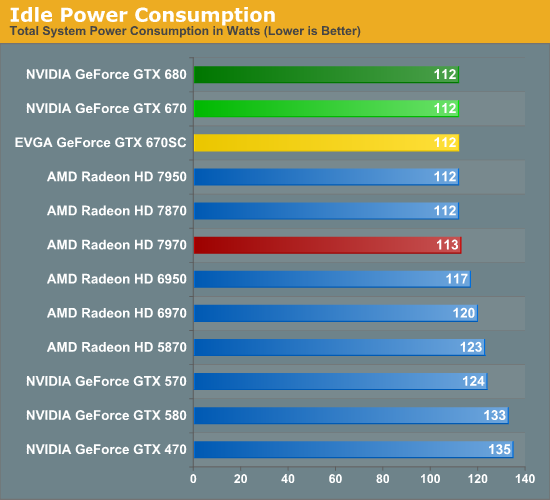
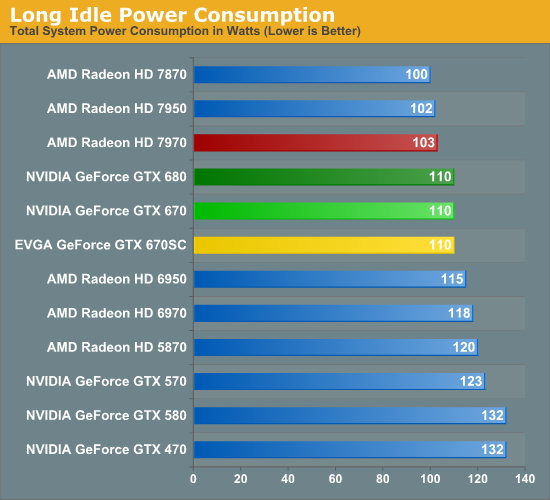
Starting with idle power, there aren’t any major surprised compared to the GTX 680. NVIDIA and AMD have both done such a good job managing their idle power consumption that even with the disabled SMX there’s no measurable difference between video cards. GTX 680 and GTX 670 effectively have the same idle and long idle power consumption.
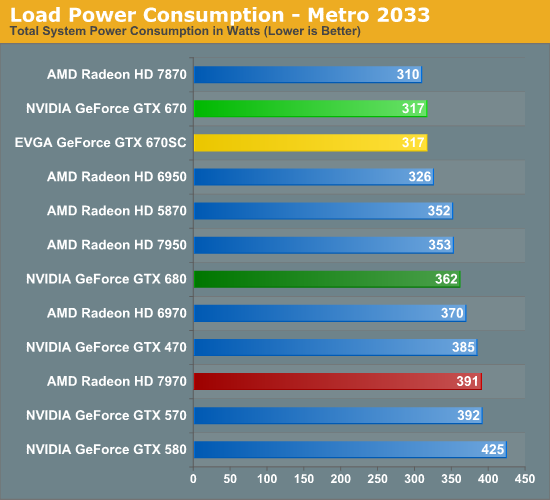
Moving on to load power consumption we can immediately see the GTX 670’s lower power target come into play. At 317W from the wall it’s 45W less than the GTX 680 for roughly 90% of the gaming performance, and this is in fact is lower power consumption than anything except the Radeon HD 7870. Even the GTX 560 Ti (which isn’t in this chart) is higher at 333W, reflecting the fact that GK104 is the true successor to GF114, and which would make GTX 670 the successor to GTX 560 from a design perspective.
Of course this also means that GTX 670 does very well for itself compared to AMD’s cards. We saw GTX 670 slightly outperform 7950 in Metro and here we see it drawing 36W less at the wall at the same time. Or compared to the 7970, 7970 can outperform GTX 670 by about 10%, but we’re drawing 74W more at the wall as a result.
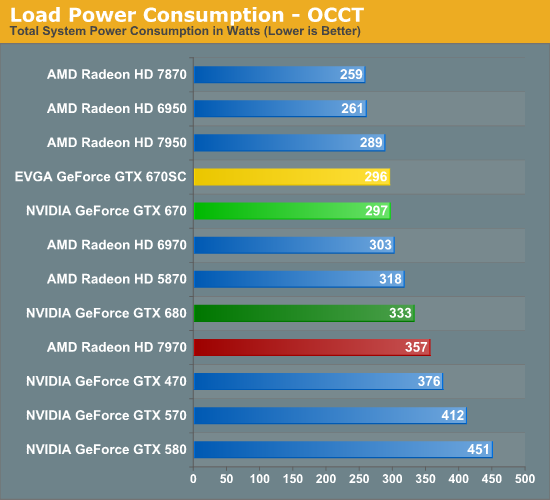
Relative power consumption shifts slightly under OCCT, but the story is otherwise similar. It’s not immediately clear why GTX 670’s power consumption is slightly higher than 7950 even after what we saw with Metro (PowerTune should be capping at 200W), but at least in this test the GTX 670 does end up doing a bit worse. On the other hand it’s still 60W less than the 7970.
Otherwise if we compare the GTX 670 to the GTX 680 we see that the GTX 680 ends up drawing 36W more at the wall, only a bit less than the difference we saw under Metro and quite close to what we’d expect based on the cards’ specifications.
On a related note, pay close attention to NVIDIA’s power target system in action here. In spite of the fact that the GTX 670SC is a binned part running at a lower voltage and higher clockspeeds, it’s drawing 1W less than the reference GTX 670. It would appear that NVIDIA has very good control over their power consumption overall, even if they can only adjust clocks for it a few times per second.
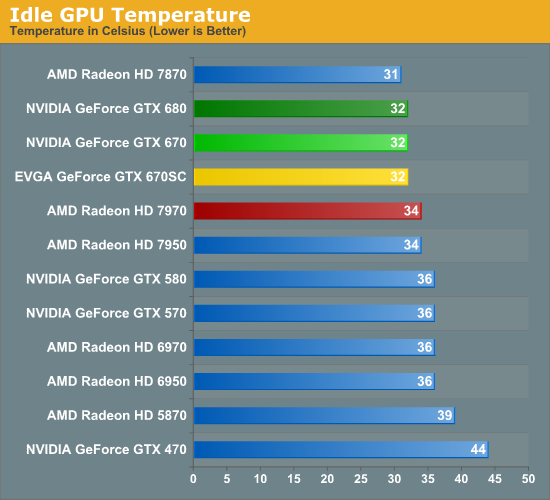
Seeing as how NVIDIA is using roughly the same cooler design with GTX 670 as they are with GTX 680 and they have the same idle power consumption, it should come as no surprise that temperatures are so similar. 32C is among the lowest of the temperatures we’ll see for a blower unless it’s running fast & loud.
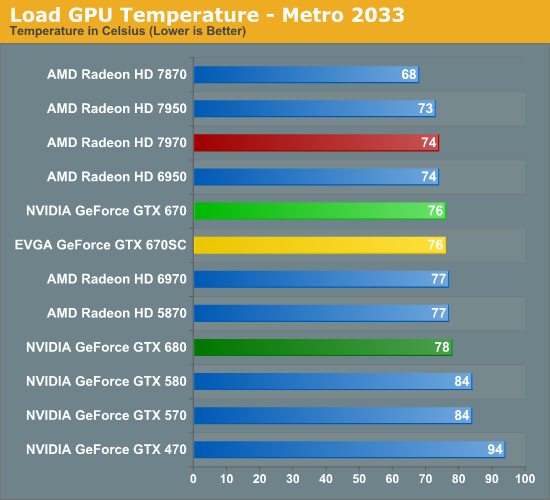
Thanks to the lower power consumption of the GTX 670 temperatures have gone down as well. 76C is still 2C warmer than the Radeon HD 7900 series due to AMD’s more aggressive cooler but it’s 2C cooler than the GTX 680. The thermal threshold for GK104 is 98C, which means there’s still over 20C of thermal headroom to play with here.

OCCT pushes temperatures up some, but not by much thanks to NVIDIA’s power target system. Since the GTX 680 tied the 7970 at 79C here, this means the GTX 670 is 2-3C cooler than both the GTX 680 and the 7970, and 0-1C warmer than the 7950.
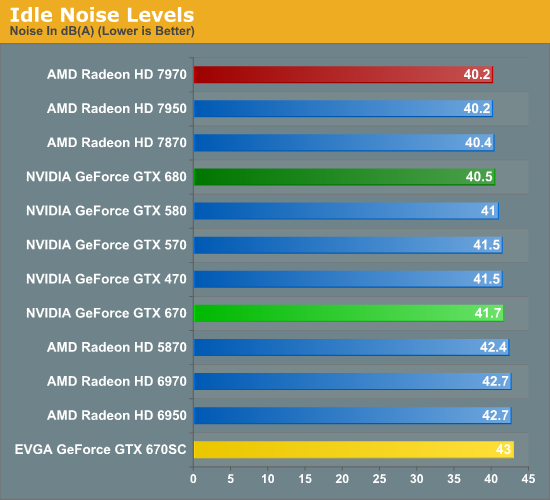
Unfortunately the impressiveness of the GTX 670 begins to wane some here at noise. NVIDIA tells us that the GTX 670 uses the same fan as the GTX 680 but this seems questionable. 41.7dB is not significantly louder than the GTX 680’s 40.5dB, but there’s a definite difference in pitch compared to the GTX 680. The GTX 670 seems to have a low pitch hum/grind to it that GTX 680 didn’t have.
Meanwhile EVGA’s card fares the worst here, at the precipice of falling out of the quiet zone. Since it’s using what’s fundamentally the same fan and cooler as the reference card, the only practical explanation is that EVGA’s smaller diameter fan intake has a negative impact on fan noise.
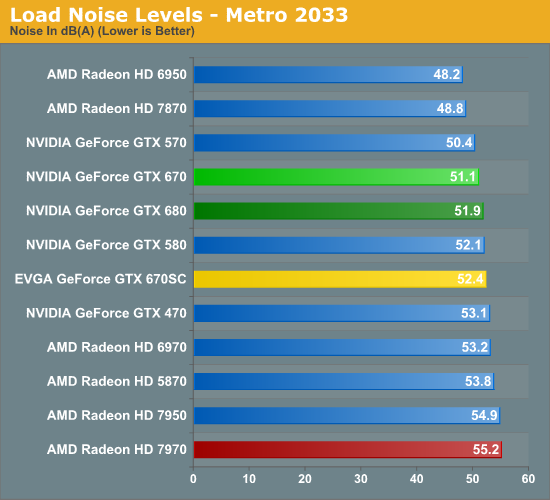
Finally, when looking at load noise we see that the GTX 670 doesn’t fare significantly better or worse than the GTX 680 here. At 0.8dB quieter than the GTX 680 the GTX 670 is a smidge quieter, but it’s nothing that’s particularly appreciable. Perhaps the more important fact is that this is 3.8dB quieter than the 7950 and 4.1dB quieter than the 7970, making the GTX 670 notable quieter than either 7900 series card. In practice the only place the GTX 670 loses is oddly enough to the GTX 570. The GTX 570 was 0.7dB quieter than the GTX 670 despite the former’s much higher power consumption. NVIDIA did let the GTX 570 get hotter than the GTX 670 so it looks like the GTX 670’s fan curve is a bit more aggressive than the GTX 570’s.
As for the EVGA GTX 670 Superclocked we’re seeing the same thing that we saw at idle: it’s just a bit louder than the reference GTX 670. This is in spite of the fact that the GTX 670SC’s fan actually went to the same speed as the reference GTX 670’s fan in this test.
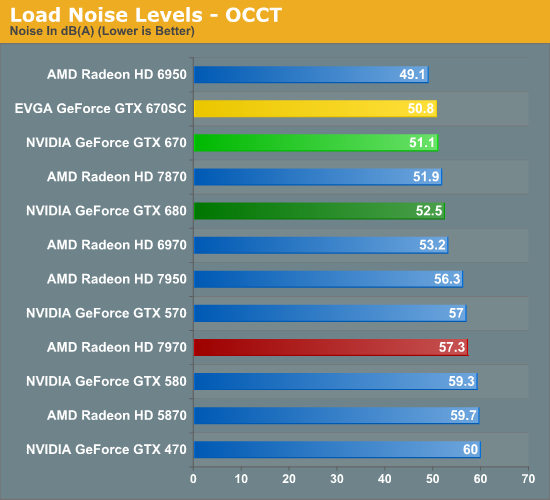
NVIDIA’s power target once more makes itself known here, thanks to which power consumption and thereby heat generation increases very little compared to what we saw under Metro. This widens the gap between the GTX 670 and 7900 series, which is now at 5.2dB and 6.2dB compared to the 7950 and 7970 respectively. Or compared to NVIDIA cards this is 1.4dB quieter than the GTX 680 and nearly 6dB quieter than the unthrottled GTX 570.
Meanwhile there’s something very interesting going on with the GTX 670SC that’s a wider reflection of the GTX 670’s reference fan. The fan speed went up but objective noise (A-weighted) went down. Why? That low-pitch hum we mentioned diminishes with a higher fan speed, and as a result the fan gets quieter once it passes a certain threshold. Subjectively we agree with our sound meter: the GTX 670SC sounds quieter here than it does as the lower fan speed it uses for cooling during Metro. We haven’t experienced anything like this with the GTX 680, which makes us further doubt that the fans are identical between the GTX 680 and GTX 670. Close no doubt, but not the same.
Wrapping things up this entire scenario is very similar to how we saw the launch of the GTX 680 play out. NVIDIA has a strong performing part with less noise and less power consumption than either its 500 series predecessors or AMD’s closest competition. This in turn was a big part of what made the GTX 680 so easy to recommend, as better performance with less noise is exactly the kind of direction we like to see video cards move in.










414 Comments
View All Comments
Galidou - Saturday, May 12, 2012 - link
Massive smackdown, lol it made AMD lower it'S prices by 50-60$, that's not massive.You know what's massive, my two radeon 6870 that I paid 130$ each and still compete with those 400$ cards... That's a massive smackdown because I bought them almost A FREAKING YEAR AGO. Take that abuser of the word ''massive'' :P
SlyNine - Sunday, May 13, 2012 - link
Not sure that comments was meant for me. I agree with you.CeriseCogburn - Sunday, May 13, 2012 - link
I very recently ( a couple months ago) recommended a 6870 to a very close friend, I think the price was about $159 and it had maybe some rebate at the egg.He bought it and has been running it for his several sims, it was the best bang for the buck at the time in a level above his then current 3 or 4 running vid cards ( 4000+5000 series).
So no doubt amd can have a deal worth purchasing, it's just not there at all in these 2 new generations. Not even a tiny bit.
Galidou - Sunday, May 13, 2012 - link
And what's the reason for that, do you know? It's not because Nvidia IS SO FAR SUPERIOR ffs stop with that, it may be superior but it's not a civic vs a ferrari. AMD had the price/performance/die size superiority because they'Ve been doing(since radeon 4870) a shift in making the most heavy gpus in the world.Nvidia was focusing on a more computationnal approach and biggest gpu, strongest performance since... well since it's alive I think. Nvidia simply took AMD's way for this gen, forget about compute power a little and focus on smaller die for mazimum performance and low consumption while AMD made the move the other way, improved their compute power at the cost of die size and power consumption.
That's what GCN is all about. it'S about the same thing that happened with GTX 2xx vs radeon 48xx cept that 4870 was more than TWICE smaller than GTX 2xx and almost as performant and sometimes even more. Not a mere 43% difference in die size, MORE THAN DOUBLE the size and still were so close in performance.
And why am I doing this analysis and you didn't, because you were too much occupied at launching inflammatory disrespectful stuff, like lots of nvidia fanboys do. People don't deserve this in a ''computer part'' oriented discussion. You were at the same time saying people were stupid and disrespectful while you were doing the same, let's say even worse.
Now get a neutral vision of things before commenting like you do, you wanna be a fanboy, at least do it in the light of respect. Did I call you any names now? Did I have to use the words ''stupid'', ''analphabet'', ''dumbfuck'', and so on... No because that was meaningless. Learn from the best of die like the rest.
CeriseCogburn - Sunday, May 13, 2012 - link
Yes you're a smack talker name calling disrespectful jerk.Yes of course you did, and you're a red fanboy and angry about all my absolutely valid points.
That wall of text you have there is a big zero of hate - some toward me, so playing some innocent jay card doesn't work either, and BTW you've now posted a curse word, something I have never done.
So you're a garbage mouth, and very disrespectful.
Galidou - Monday, May 14, 2012 - link
I never called you any names NEVER look at all my posts, I never called you even one name and you just did it again and again but I'm the one who lacks respect what's that:''disrespectful jerk.''
''you're a garbage mouth''
That word I posted was an example, it wasn't meant toward anyone it was an example.
CeriseCogburn - Thursday, May 31, 2012 - link
Oh stop your lying, you attack and call names more than anyone, it's your whole text every time.CeriseCogburn - Sunday, May 13, 2012 - link
PSangry disser Galidou " And why am I doing this analysis and you didn't, "
Why you are doing this analysis is because you are a pure amd troll and have to go back to the last generation to try to make some idiotic historical point because you have no current points and no current rebuttals.
Furthermore you claim I am somehow unsound by not having made your crybaby last generation whining no real point but I have made the more pertinent point as nVidia beat amd in every single metric here.
I guess for your "win" you need to squeal about respect as you do the same trash talk, then go back to a prior generation to try to whine about what exactly ?
You having a neutral vision is one big fat joke.
You're in with all the amd fanboys here telling lies and going back a generation and whining about that...
It would be nice if your snide remarks could be directed at pertinent points I have made but so far you're incapable, and often just on a troll attack against me personally in at least two of your other posts.
What were you spewing about up there anyway ? Power ? LOL
Guess who loses that sonny.
Galidou - Monday, May 14, 2012 - link
these are the words you currently used in about 4-5 posts of yours, I don'T want to make any point with you toward video cards related discussion because of that, these are the words you use, I just want you to realize what you do:''pathetic amd fanboys
massive ignorance
disrespectful jerk
smack talker
angry disser
you're so ignorant
most ignorant and clueless fools
Where exactly is the brain ?
(roll eyes at the immense ignorance, again)''
and then at the same time use a sentence like:
''Thank me when you grow up enough to realize rebutting lies and fibs by others is an adult and responsible''
The attitude words you used up there are so responsible... but no, you could just make your point and end it with a ''.'' but you ahve to add those words attacking everyone in your way, but sorry I forgot, I'm the one who attacks you, you're the perfect one... I'm maybe a troll but I'm not mad like you are.
But hey, your arguments are so right that you gotta use all this stuff in your argumentation and call everyone a mad hater. Who's the hater? I already like Nvidia I'm no AMD fanboy.
CeriseCogburn - Thursday, May 31, 2012 - link
You're a total amd fanboy and a liar, and attacker, and name caller, and cursing rude jerk.I'm sure you enjoy playing an angel in between all of that.